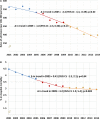National Trends in Admission and In-Hospital Mortality of Patients With Heart Failure in the United States (2001-2014)
- PMID: 29187385
- PMCID: PMC5779014
- DOI: 10.1161/JAHA.117.006955
National Trends in Admission and In-Hospital Mortality of Patients With Heart Failure in the United States (2001-2014)
Abstract
Background: To investigate heart failure (HF) hospitalization trends in the United States and change in trends after publication of management guidelines.
Methods and results: Using data from the National Inpatient Sample and the US Census Bureau, annual national estimates in HF admissions and in-hospital mortality were estimated for years 2001 to 2014, during which an estimated 57.4 million HF-associated admissions occurred. Rates (95% confidence intervals) of admissions and in-hospital mortality among primary HF hospitalizations declined by an average annual rate of 3% (2.5%-3.5%) and 3.5% (2.9%-4.0%), respectively. Compared with 2001 to 2005, the average annual rate of decline in primary HF admissions was more in 2006 to 2009 (ie, 3.4% versus 1.1%; P=0.02). In 2010 to 2014, primary HF admission continued to decline by an average annual rate of 4.3% (95% confidence interval, 3.9%-5.1%), but this was not significantly different from 2006 to 2009 (P=0.14). In contrast, there was no further decline in in-hospital mortality trend after the guideline-release years. For hospitalizations with HF as the secondary diagnosis, there was an upward trend in admissions in 2001 to 2005. However, the trend began to decline in 2006 to 2009, with an average annual rate of 2.4% (95% confidence interval, 0.8%-4%). Meanwhile, there was a consistent decline in in-hospital mortality by an average annual rate of 3.7% (95% confidence interval, 3.3%-4.2%) during the study period, but the decline was more in 2006 to 2009 compared with 2001 to 2005 (ie, 5.4% versus 3.4%; P<0.001). Beyond 2009, admission and in-hospital mortality rates continued to decline, although this was not significantly better than the preceding interval.
Conclusions: From 2001 to 2014, HF admission and in-hospital mortality rates declined significantly in the United States; the greatest improvements coincided with the publication of the 2005 American College of Cardiology/American Heart Association HF guidelines.
Keywords: heart failure; hospitalization; mortality; outcome; quality of care.
© 2017 The Authors. Published on behalf of the American Heart Association, Inc., by Wiley.
Figures




References
-
- Mozaffarian D, Benjamin EJ, Go AS, Arnett DK, Blaha MJ, Cushman M, Das SR, de Ferranti S, Despres JP, Fullerton HJ, Howard VJ, Huffman MD, Isasi CR, Jimenez MC, Judd SE, Kissela BM, Lichtman JH, Lisabeth LD, Liu S, Mackey RH, Magid DJ, McGuire DK, Mohler ER III, Moy CS, Muntner P, Mussolino ME, Nasir K, Neumar RW, Nichol G, Palaniappan L, Pandey DK, Reeves MJ, Rodriguez CJ, Rosamond W, Sorlie PD, Stein J, Towfighi A, Turan TN, Virani SS, Woo D, Yeh RW, Turner MB. Heart disease and stroke statistics‐2016 update: a report from the American Heart Association. Circulation. 2016;133:e38–e360. - PubMed
-
- Fang J, Mensah GA, Croft JB, Keenan NL. Heart failure‐related hospitalization in the U.S., 1979 to 2004. J Am Coll Cardiol. 2008;52:428–434. - PubMed
-
- McCullough PA, Philbin EF, Spertus JA, Kaatz S, Sandberg KR, Weaver WD. Confirmation of a heart failure epidemic: findings from the resource utilization among congestive heart failure (reach) study. J Am Coll Cardiol. 2002;39:60–69. - PubMed
Publication types
MeSH terms
LinkOut - more resources
Full Text Sources
Other Literature Sources
Medical
Research Materials
Miscellaneous

